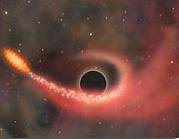Sagittarius A
 Sagittarius A is the name atronomers have given the massive object that lies at the center of the galaxy. Today, Space.com reports that a new estimate of the object's size, pegging its diameter as roughly 93 million miles -- about the distance from the Sun to the Earth. The new estimate halves the previous estimate, which posited that Sgr A was of about the same area as that carved out by the Earth's orbit of the Sun.
Sagittarius A is the name atronomers have given the massive object that lies at the center of the galaxy. Today, Space.com reports that a new estimate of the object's size, pegging its diameter as roughly 93 million miles -- about the distance from the Sun to the Earth. The new estimate halves the previous estimate, which posited that Sgr A was of about the same area as that carved out by the Earth's orbit of the Sun.What is Sgr A? The smart money is on a super massive (4 million times the mass of the sun(!)) black hole. What I find interesting is the competing theory: A giant turtle. Seriously, though, some believe Sgr A:
might be a cluster of millions of collapsed dead stars, called neutron stars. If that were the case, the stars would only survive for about 20,000 years. At the end of that time, they would either collapse into black holes themselves or evaporate away into space.Let's see. Millions of neutron stars, many (at least more than one or two) of which would collapse into black holes after 20,000 years, all packed into an area the diameter of which is about the distance between the Earth and Sun. It seems to me that if even a small handful of these neutron stars formed black holes, they would quickly swallow each other up, as well as swallow up all the remaining neutron stars. That is, after all, what black holes do.
If this hypothesized neutron star garden does exist at the galatic core, it would seem we are living in a very curious point in the history of the galaxy. 20,000 years is, on the time scale of the universe, barely even a pinch of a snippet of a fraction of a fleeting moment. Indeed, so far away is the galatic core that it takes light from the core about 50,000 years to reach Earth. Hence, if what we are observing at Sgr A is a neutron star garden, it is already, in fact, the black hole that we will observe when the light emitted today from the center of the galaxy finally reaches us.
I find it interesting we exist -- with the ability to make such observations -- at precisely the brief point in galactic history during which such a strange thing exists for observation. The theory is probably incorrect -- Sgr A is most likely a garden variety (if there is such a thing) black hole such as exists in most galaxies. If, on the other hand, the theory is correct, it is, in the scientific vernacular, pretty darn cool all around.


<< Home